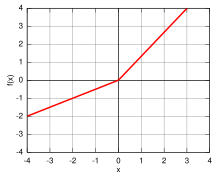Sublinear function
In linear algebra, a sublinear function or sublinear mapping is a real-valued function on a real or complex vector space that is positively homogeneous and subadditive . Sub- linear functions thus represent a certain generalization of linear functions , which, as the more stringent requirements, must be homogeneous and additive . In particular , every sublinear function is convex ; conversely, every positive homogeneous and convex function is sublinear. Sublinear functions play a central role in functional analysis in Hahn-Banach's theorem .
definition
A real-valued function on a vector space over the real or complex numbers is called sublinear if the following two conditions are met for all positive real numbers and for all vectors :
- ( Positive homogeneity )
- ( Subadditivity )
The homogeneity required here is degree one. The restriction of to the positive real numbers in the definition is important, because subadditive and homogeneous functions for all real numbers are already additive and therefore linear .
Examples

- Real-valued linear functions are sublinear; the same also applies to the amount of real or complex-valued linear functions.
- Norms and semi-norms are sublinear; likewise Minkowski functionals on convex and absorbing sets.
- For bounded complex-valued sequences the limes superior of the real parts of the sequence members is a sublinear mapping.
properties
zeropoint
In the zero point , a sublinear function always has the value zero , which is evident from the positive homogeneity by setting over
follows. Therefore, the requirement for positive homogeneity can also be extended to the non-negative real numbers . A sublinear function can also have further zeros ; in particular, the null function is sublinear.
Positivity and negativity
Sublinear functions can generally have negative values. But if at one point , it must be due to
apply at the point that is. A sublinear function therefore assumes positive values in at least as many places as it assumes negative values.
convexity
Every sublinear function is convex , whatever real from the subadditivity and the positive homogeneity directly over
follows. Conversely, every positively homogeneous and convex function is subadditive and therefore sublinear, which is achieved by setting means
can be shown. In the definition above, the subadditivity can also be replaced by convexity.
application
An important application of sublinear functions can be found in Hahn-Banach's theorem . Accordingly, a linear functional on a sub-vector space of a real vector space, which is restricted by a sub-linear function, has a linear continuation on the total space, which is also restricted by this sub-linear function. As a consequence, Hahn-Banach's theorem ensures the existence of a sufficient number of continuous and linear functionals in a standardized space and thus forms a central basis for functional analysis .
literature
- Dirk Werner : Functional Analysis . Springer, Berlin 2007, ISBN 978-3-540-72533-6 .
- Peter Kosmol: Optimization and Approximation . de Gruyter, 2010, ISBN 978-3-11-021814-5 .






















